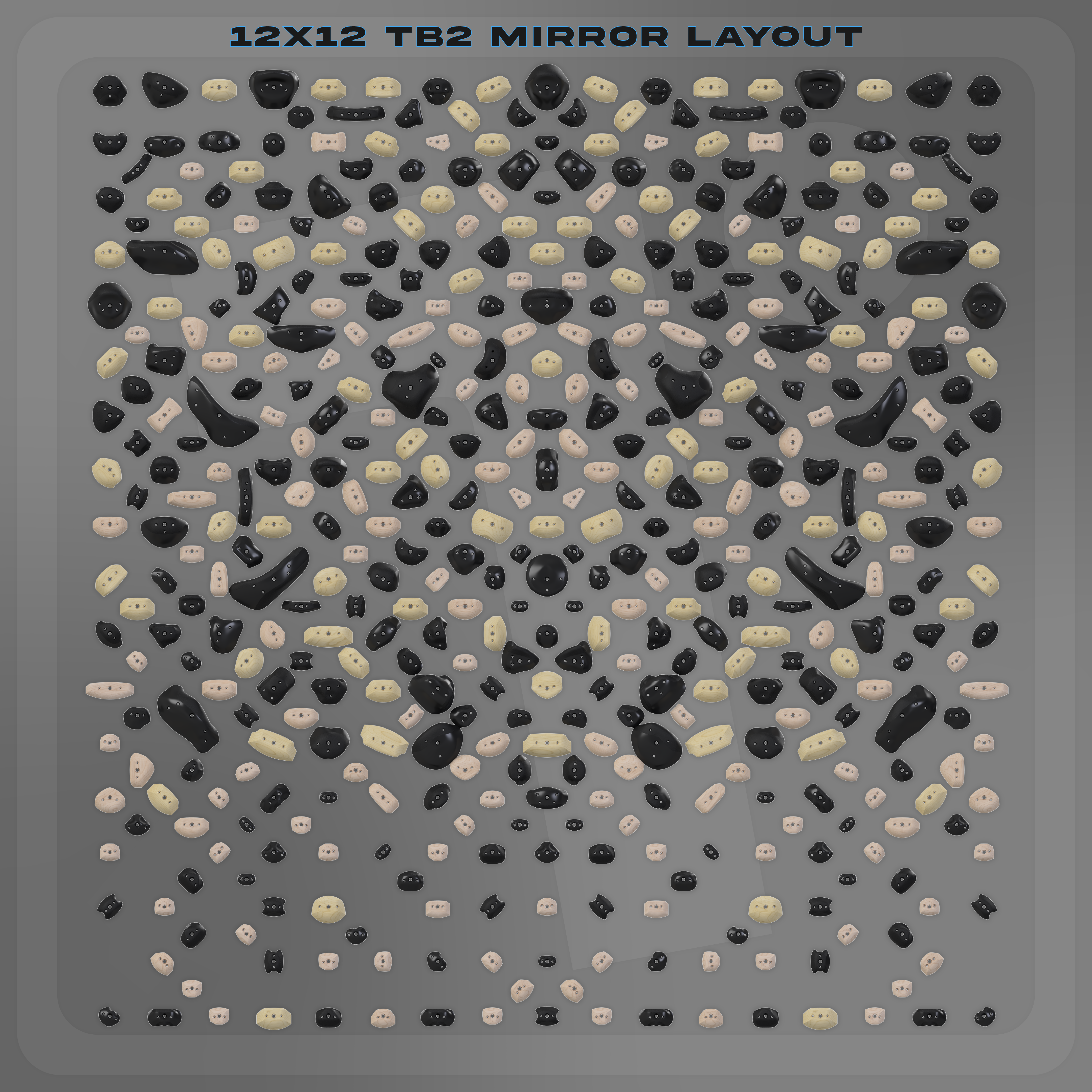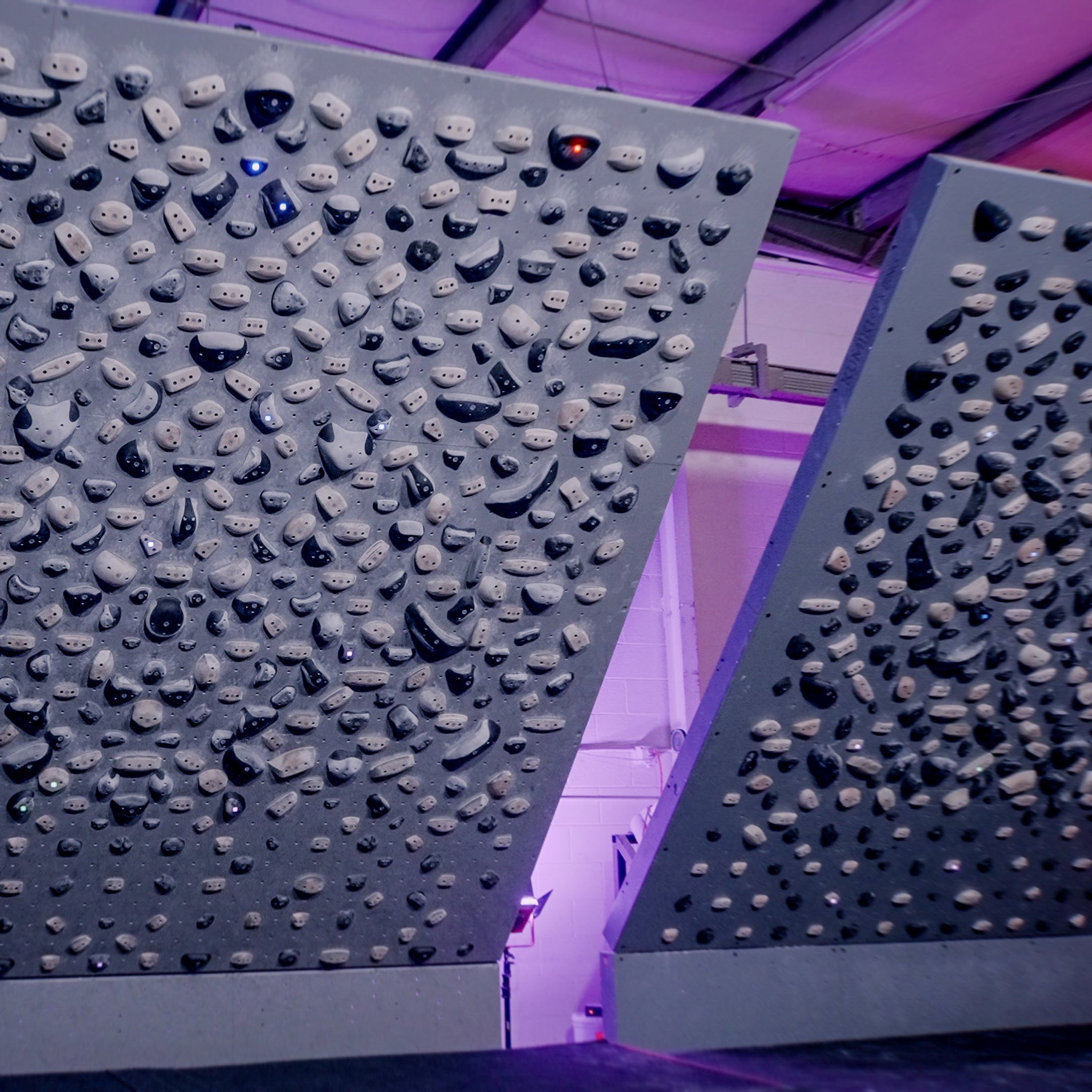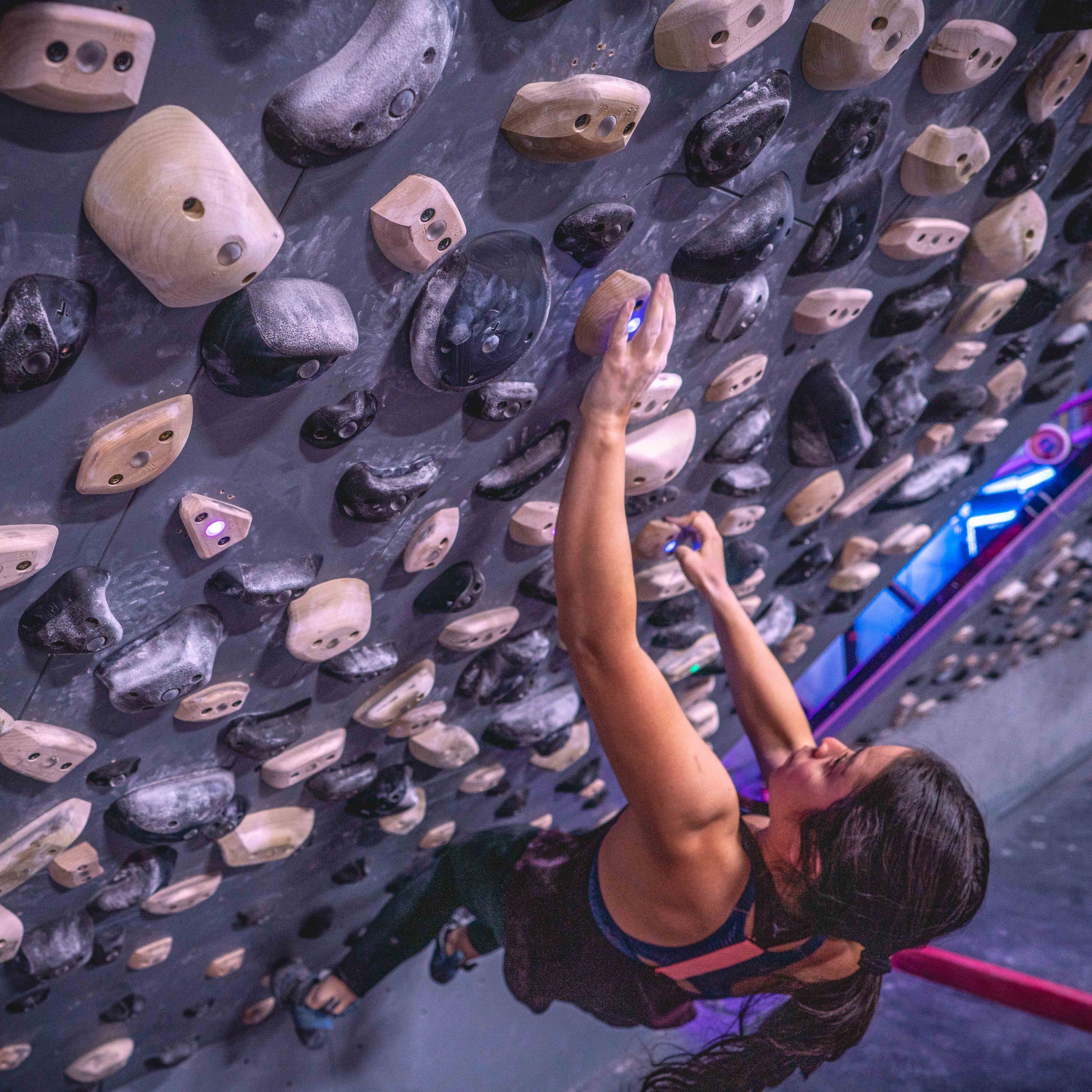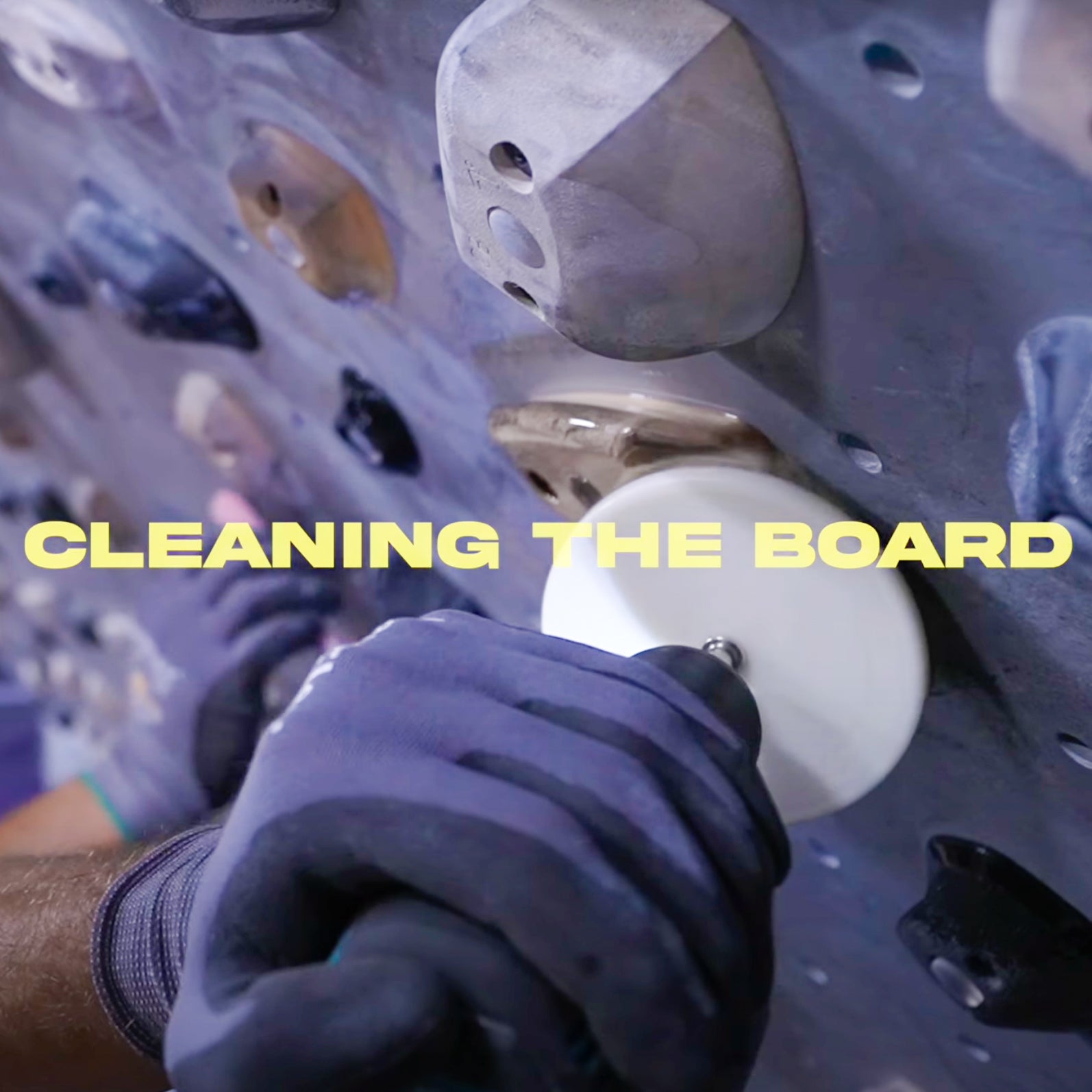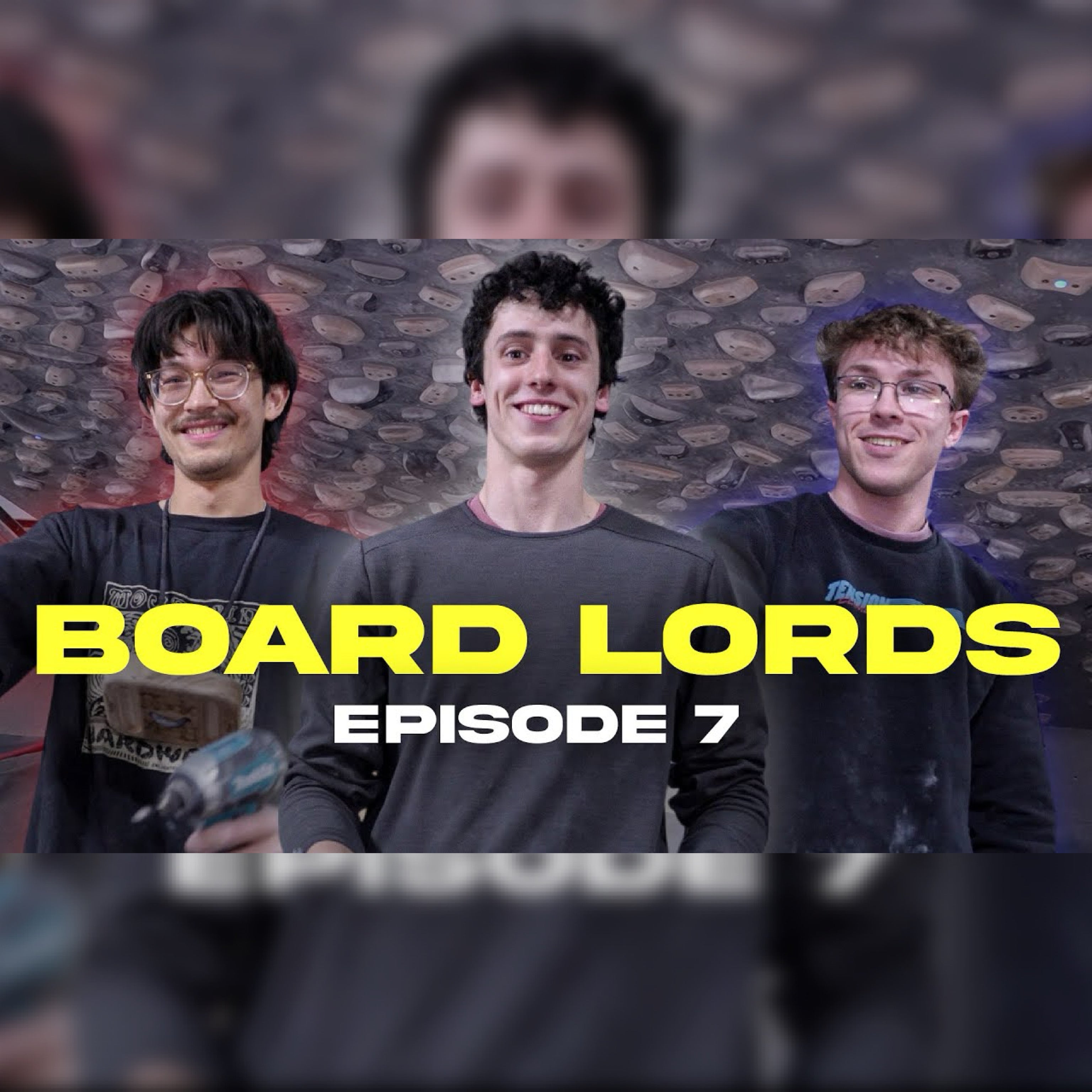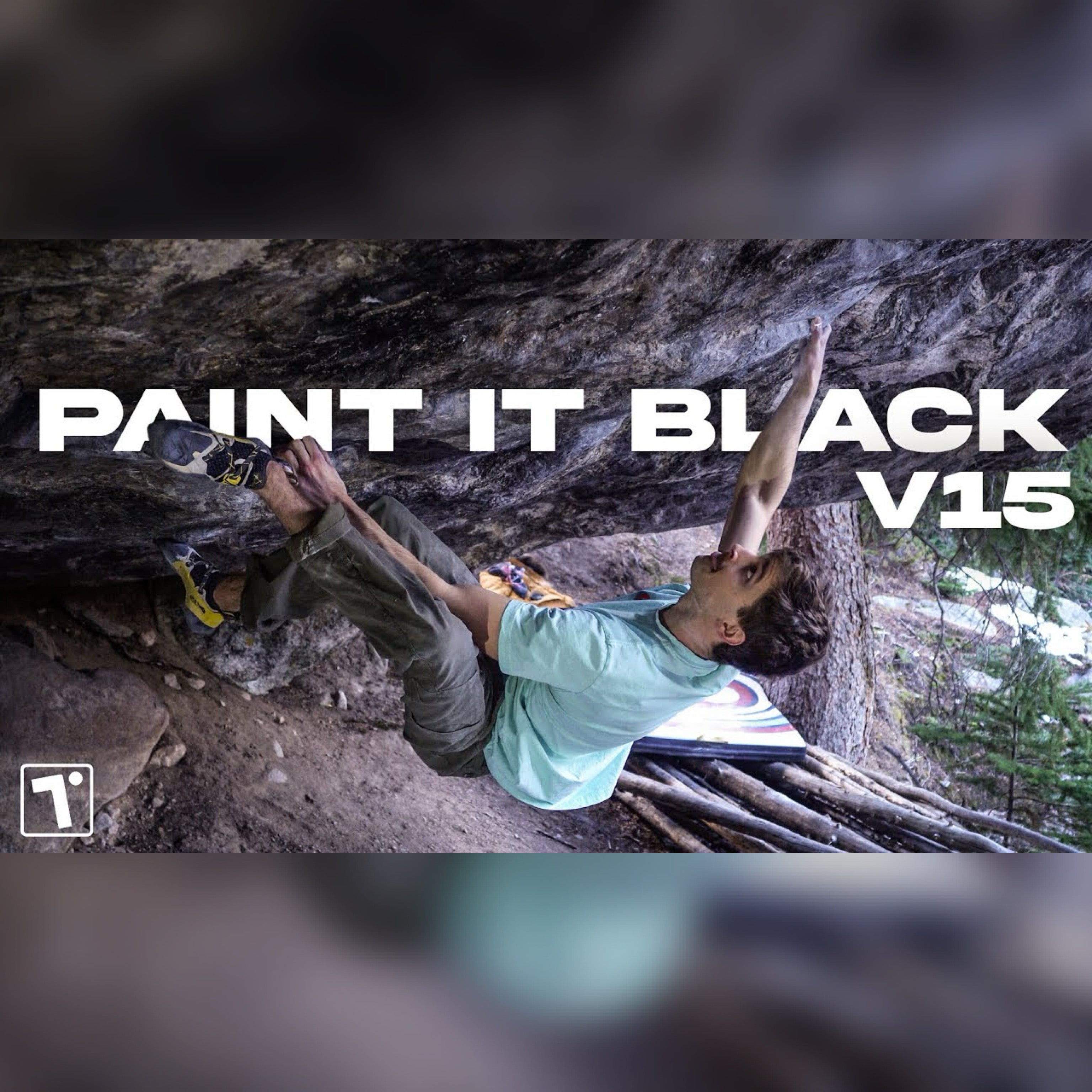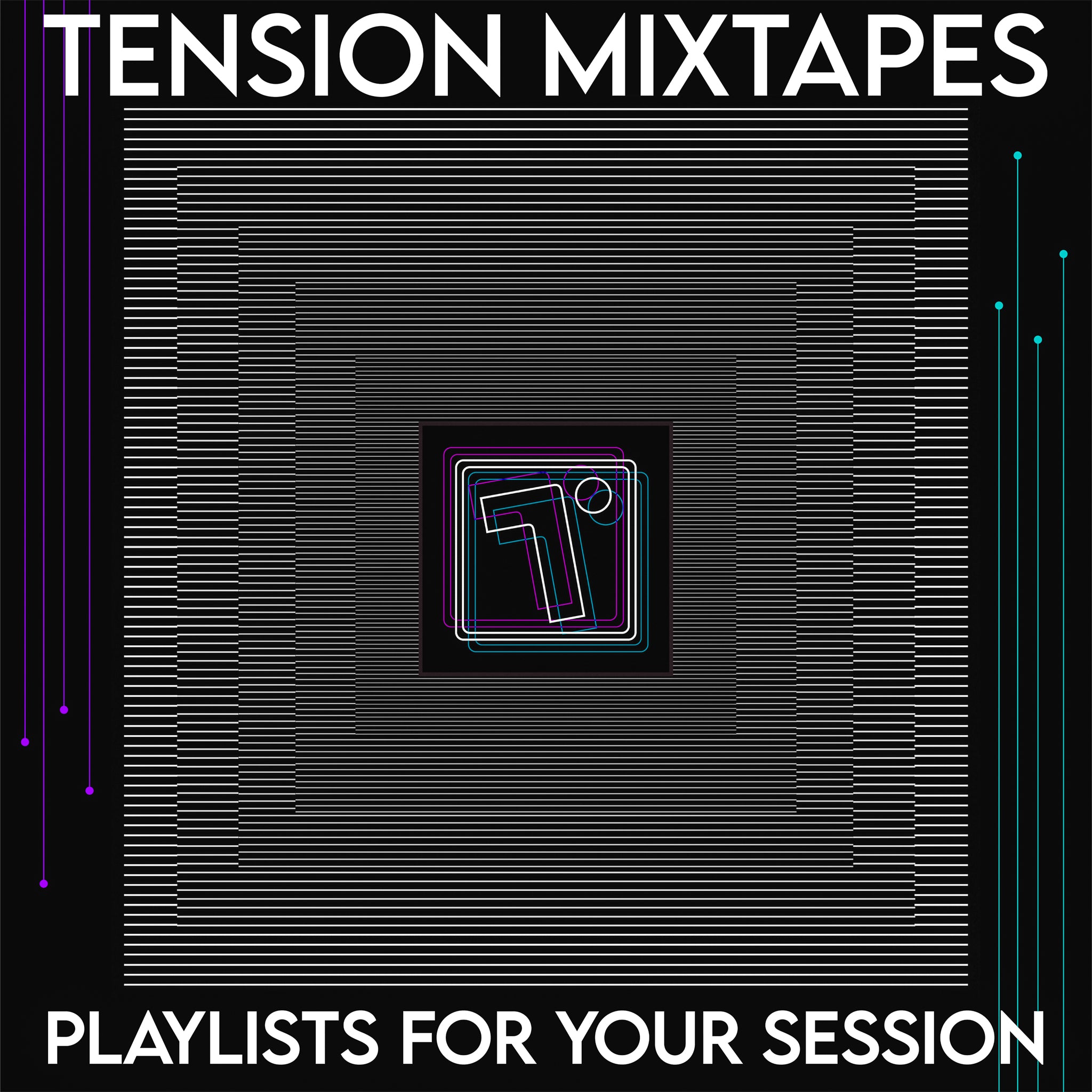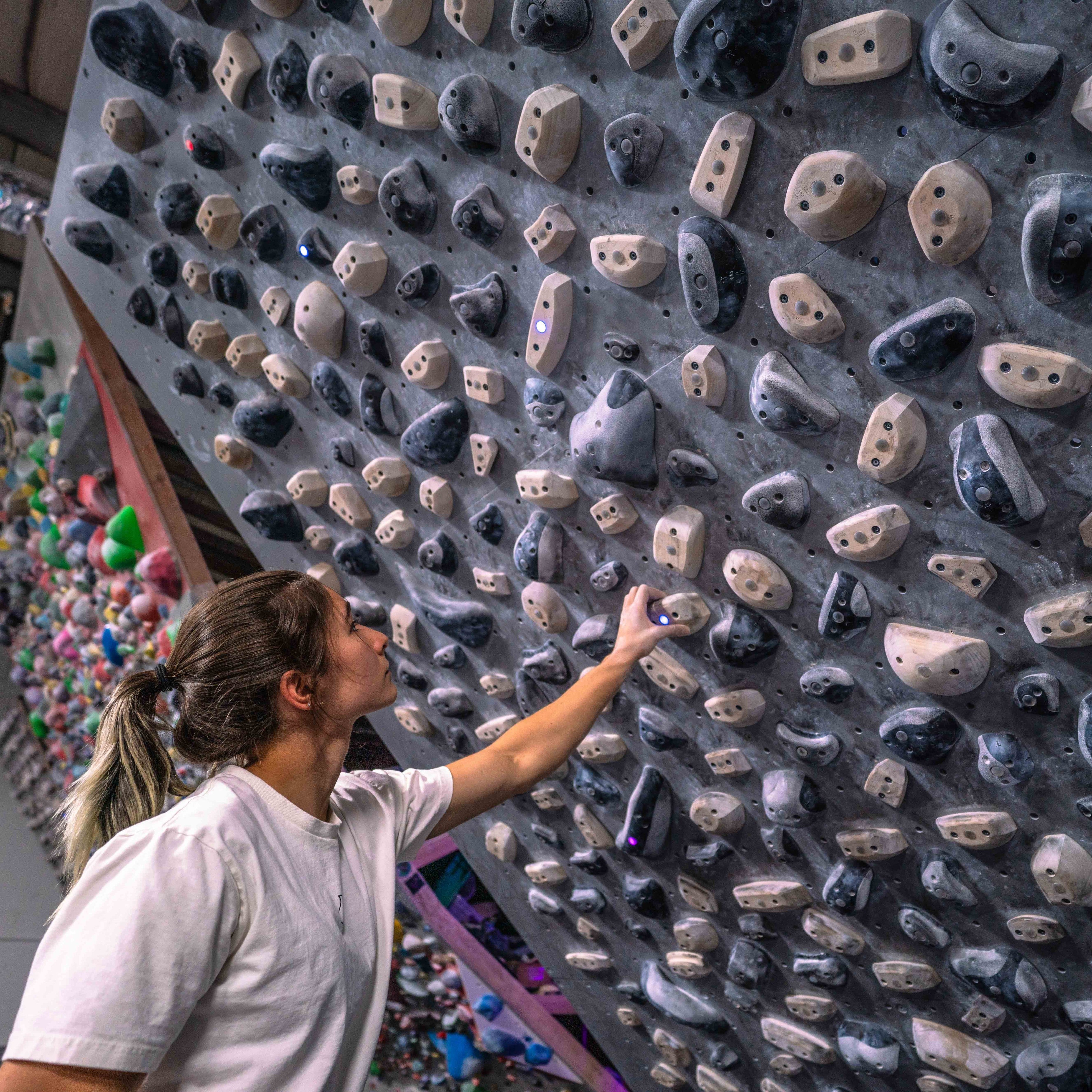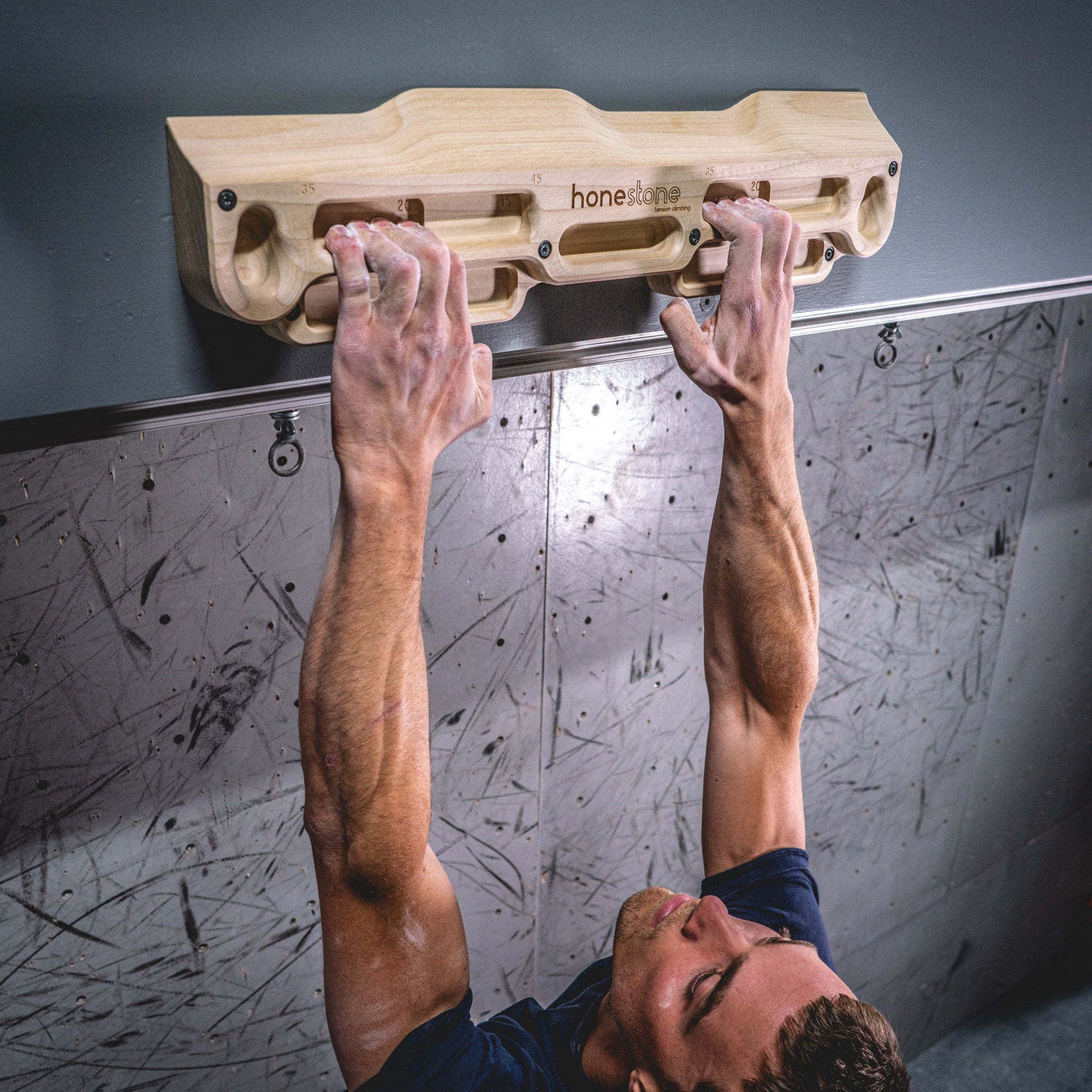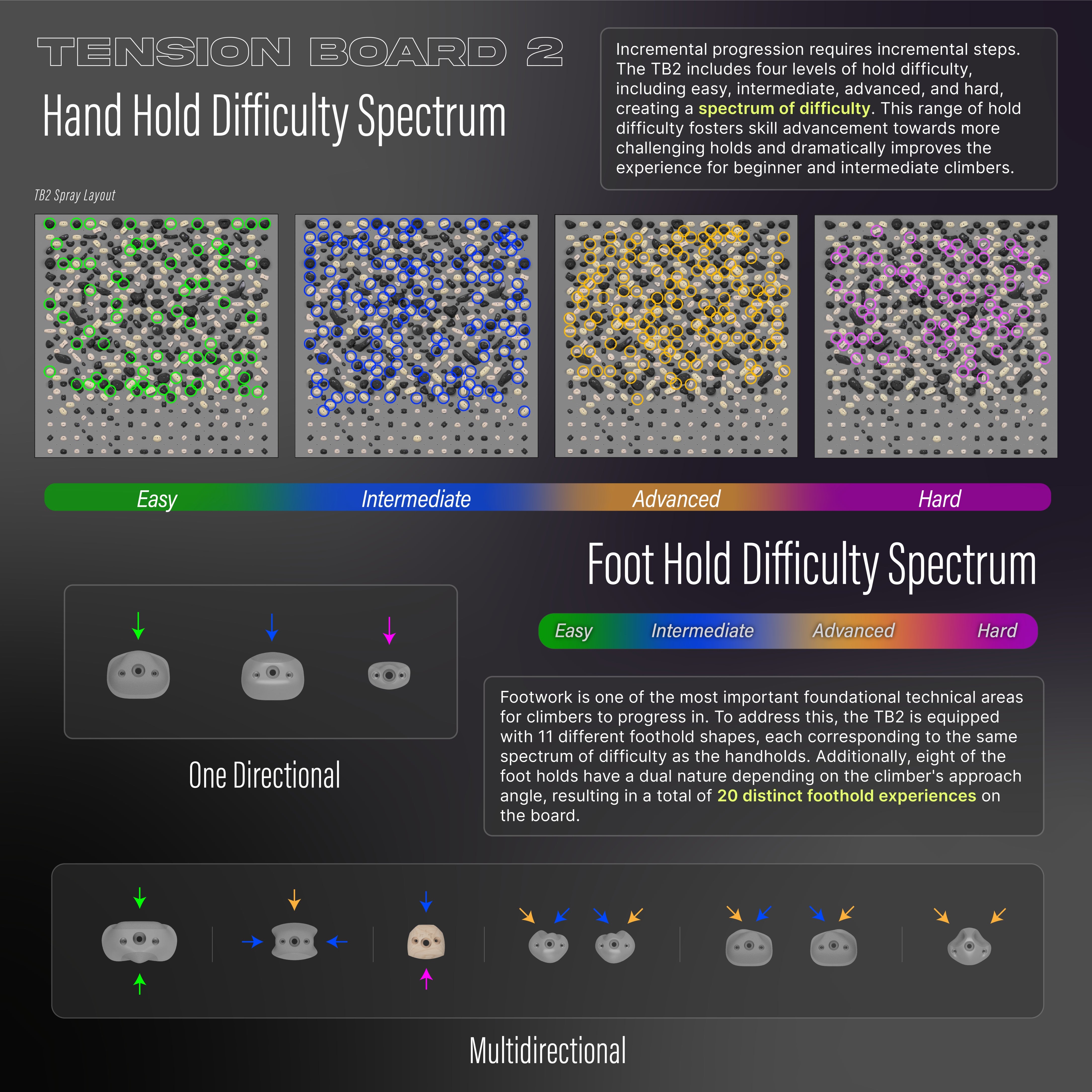
Minh Tran examining the holds on the TB2
Over the last 20 years, standardized LED climbing boards have become an undeniable presence within the climbing industry— they're now an essential feature of every modern climbing facility, and it's easy to see why. Standardized LED boards are boulder fields in their own right. Each has its own unique hold types, climbing styles, and app-based communities that create unified experiences for climbers all over the world.
While it is clear the popularity of these systems has surged over the past decade, with most climbing boards emerging in the last five years, it is not quite clear what makes the user experience on each of these systems distinct—and more importantly, how these various systems help engage and assist users in progressing as climbers. With the recent release of the Tension Board 2 (TB2), we at Tension Climbing aim to address these points decisively.
This article examines how the TB2 integrates into the current landscape of climbing boards, highlighting the unique features that sets our new system apart. Additionally, it explores how the TB2 can support climbers in their progression, fostering an engaged and loyal customer base for commercial climbing facilities.
History and Foundations
When Tension Climbing entered the board market in 2016, we did so from a completely different angle (no pun intended) from that of Ben Moon’s Moon Board. As the second standardized LED climbing board brought to market and the first to offer angle adjustability, wood holds, and a symmetrical layout, the Tension Board 1’s (TB1) core purpose was to facilitate balanced climbing progression by helping climbers easily identify and target specific weaknesses.

The Tension Board 1
Our team achieved this by expanding on the symmetrical design of the Huber Brother’s iconic System Board — giving the TB1 the unique ability to illuminate the mirror opposite of each climb in the board’s app-controlled database. The TB1 introduced climbers to the utility and effectiveness of wall angle adjustment, climbing on wooden holds, and climbing the same boulder on both sides of the median.
While the Moon Board gave new life to the asymmetrical spray wall, the TB1 cemented the importance of symmetry in board climbing. This established the fundamental divergence in hold layout types that has since become a key differentiator between every LED system available today.
Mirror or Spray?

Standardized LED climbing boards by layout
When observing various standardized boards on the market, the first area to consider is the distinction between spray vs mirrored hold layouts.
Is one layout better than the other? The answer isn’t straightforward; rather, it is specific to the individual and largely depends on a climber’s motivations, which can and often do change over time.
While a mirrored layout does allow climbers to train in a more balanced and systematic way, it can often feel limiting to those who prioritize more overall movement possibilities. On the flip side – though a spray layout can produce more movement and setting scenarios for climbers, it offers limited ways for users to train in a balanced and systematic way.
In other words, both types of boards offer their own unique benefits.
This notion became the catalyst for our nearly five-year endeavor to create the ultimate platform for climbing progression. An effort that would elevate standardized LED boards beyond expectations.
A Hybrid System; An Adaptable Platform
 Mirror and Spray Layouts of the TB2
Mirror and Spray Layouts of the TB2
Debuting in late October 2022, the Tension Board 2 set out to become the premier standardized board for climbing progression. Recognizing the unique advantages of both spray and mirror layouts, we designed the TB2 as a hybrid system, offering both layout options from a single versatile hold set. This innovative feature not only allows the customer to choose the layout that best suits their specific needs, it also allows them to change the layout at any point – effectively serving as an adaptable platform that can change to fit the climber’s specific needs in the future.

Tension introduces the TB2 Hybrid System, including both Spray and Mirror Layouts from one hold set.
During the TB2’s multi-year R&D process, we focused on key aspects of climbing skill progression, and in doing so, evaluated those represented in modern standardized boards. Surprisingly, our team discovered that every leading system, including our own TB1, lacked essential components necessary for fostering incremental and comprehensive climbing improvement.
As a result, we designed the TB2 around the following variables we believe are integral for fostering broad skill progression on standardized climbing boards:
- Full range of hold difficulty (easy-hard)
- High degree of hold diversity (wide variations of holds)
- Large quantity of hand and foot holds
- Spectrum of grip textures
- Broad wall angle adjustability

The TB2 layout design process
Our team regards the TB2 as a synthesis of these principles. By applying these variables to skill development, the TB2 offers a full spectrum of engaging learning experiences for beginner to advanced climbers.
7 Areas for Skill Development on the Tension Board 2

Rachel Robinson climbing on the TB2 Spray Layout
1. Incremental Advancement Towards More Challenging Holds
Incremental progression requires incremental steps. But what does this mean in relation to standardized boards and more specifically the holds represented on them? We believe the answer is simple: a full range of hold difficulty must be present to facilitate advancement for novice climbers, advanced climbers, and all skill levels in between.
It does not benefit climbers beyond a certain level to blanket a board in only easy to intermediate holds as this will greatly limit the degree and breadth of skill progression achievable by users. Conversely, a board with only intermediate to hard holds creates a higher barrier to entry, effectively alienating beginner climbers from using the board.

The handhold difficulty spectrum shown on the TB2 Spray Layout
Our team designed the TB2 with four levels of hold difficulty, including easy, intermediate, advanced, and hard – effectively creating a spectrum of difficulty. This range of hold difficulty dramatically improves the experience for beginner and intermediate climbers.
Additionally, the holds are shaped to scale difficulty incrementally as the wall angle is adjusted – ensuring a high level of usability across angle changes. This design feature makes the board both accessible and engaging for a broad range of climber experiences and ability levels.
2. Balanced and Targeted Training
Climbers can take advantage of three distinct benefits from the TB2’s symmetrical layout.
Systematic Training

Quinn Spadafora climbing both sides on the TB2 Mirror Layout
Injury Avoidance
For climbers with ongoing injuries, the Mirror Layout option allows them to change climbs to the opposite side of their injury, enabling them to avoid situations that could aggravate the injury or cause further damage.
For example, if a right-hand crux move involves a grip type that irritates a right-hand injury, climbers can illuminate the left-sided variant to switch the crux move to the left side of the body, thereby avoiding the injured area.
Rehabilitation
Similarly, the Mirror Layout can also be used to progressively rehab and strengthen specific areas of the body where an injury has occurred. Physical therapists can even use the TB2 as a prescriptive tool by creating rehab-specific protocols for injured climbers.

3. Footwork Skill Progression
Climbing coaches the world over will note – footwork is one of the most important foundational technical areas for climbers to progress in. This isn’t surprising considering how, whether outside on rock or indoors on technical vertical sequences, the lower half of the body is often where climbers fail.
This concept, however, has seemingly been lost on the majority of board systems as most primarily promote powerful movement and foot-cutting between holds as opposed to technical footwork challenges. Simply put, a system built for broad progression cannot expect to advance comprehensive skill development without a critical focus on the lower half of the body.

The Foothold Difficulty Spectrum of the TB2
As a result, one of the primary hallmarks of the TB2 is the wide quantity and diversity of foothold types. We equipped the TB2 with 11 different foothold shapes, each corresponding to the same spectrum of difficulty as the handholds. Additionally, eight of the footholds have a dual nature depending on the climber's approach angle, resulting in a total of 20 distinct foothold experiences on the board.

TB2 footholds in use
As climbers progress on the TB2, they will learn to pay greater attention to their footwork, developing the skills necessary to apply to objectives on and off the board.
4. Texture Variation Training
Throughout a climber’s journey, they will come into contact with numerous textures which they must learn to navigate in order to progress. Whether it be encountering different rock types outside or facing differing degrees of grip textures indoors, there is a learning curve to navigating these tactile variations.

The Tactile Difficulty Spectrum of the TB2
On the TB2, we use both wood and dual-texture polyurethane (dual-tex PU) holds that result in three distinct tactile experiences for climbers: high, low, and no texture.
The wooden grips, which have been completely updated and improved from those found on the TB1, fill the space of the low-texture category – promoting users to climb with a more active grip and increased body tension and awareness.
The dual-tex PU on the other hand, provides a high texture on the gripping surface with no-texture portions purposefully placed over strategic areas of the hold. The dual-natured PU demands an added level of accuracy and thoughtfulness from the climber through both the hands and feet, which is massively beneficial to overall skill development.

Allison Spatz climbing on the wooden grips of the TB2
The presence of both wood and dual-tex PU on the TB2 can also be an instrumental feature for those who want to minimize skin loss during training or for those who only want a high degree of texture. By creating an all-wooden and/or an all-plastic board within the Tension Board app, climbers can easily filter for climbs with only wooden or plastic holds. Having this high level of functionality around hold texture on a standardized board adds yet another layer to the effectiveness of the TB2 system.
5. Exposure to Numerous Climbing Styles
During the R&D process for the TB2, our team looked closely at the numerous advantages of traditional spray walls. One key advantage we observed was that spray walls are often able to produce numerous styles of boulders that feel vastly different from one another all while still being on the same board. Our team found that this is largely due to both the quantity and diversity of holds present on a typical spray wall.
As a result, we designed the holds on the TB2 system to offer some of the most diverse experiences ever produced on a standardized board. This is evident from the board’s unique appearance – representing numerous hold varieties ranging from general to very specific, hold footprints ranging from small to large, and hold sets that span a large range of hold families.

Quinn Spadafora on the sloper compression boulder, “Turnt Out” on the TB2 Mirror Layout
These variables, in conjunction with a wide array of strategically placed foot holds, produce an enormous variety of climbing styles on the TB2. Practically, this means that the TB2 can cater to whatever kind of session a user wants to have – rather than the user having to switch between different boards to target different styles and movement types.
The TB2’s hold types, sizes, textures, and orientations – combined with a global database of climbs – uniquely positions it to allow climbers worldwide to contribute and enjoy unique, nuanced climbing experiences regardless of their physical location.
See numerous styles represented on the TB2.
6. Movement Creation and Replication
Yet another advantage of traditional spray walls is the ability for climbers to engage with near-endless movement possibilities to more accurately replicate experiences external to the board. This is, again, a direct result of a spray wall’s typical high density of diverse hold types.
This fact became the primary impetus for our development of the TB2’s Spray Layout, which by all accounts, is the closest example of a true spray wall on a standardized LED system.

Derek Shad setting a boulder on the TB2 Spray Layout
With the TB2 Spray Layout, climbers can expect to experience holds in more extreme orientations compared to the Mirrored Layout. This produces situations that can feel more realistic to outdoor climbing experiences. Additionally, the Spray Layout on the TB2 represents a far more approachable “spray wall experience” given the spectrum of difficulty and accessibility built into the system, along with the integration of the LED kit and global climb database.
This approachable experience allows climbers of all skill levels to set sequences that can be more unique and complex than typical “board style” problems. Moreover, the TB2 opens the door to replicate movement so that users can practice sequences that mimic outside or inside projects.
7. Body Awareness Across a Wide Angle Range
Angle adjustment for standardized climbing boards was introduced with the arrival of the TB1 in 2016. With this new feature, our team aimed to bring an added level of dimension and control not previously achievable on fixed-angle boards.
On the TB2, angle adjustment offers an even greater level of climb customization. When combined with the board’s full range of carefully designed holds, climbers of all ability levels can climb on any angle that most closely aligns with their goals.

The peak grade range shows accessibility across a wide range of angles on the TB2
In other words, angle adjustment on the TB2 is not merely a dial for difficulty; it is a dial for experience and exposure to the wide variety of styles represented in climbing with a full range of grades accessible at all but the most extreme angles.
Impact in the Right Places
With the creation of the Tension Board 2, we made a deliberate attempt to distill all of the benefits of standardized LED climbing boards into a single adaptable system. In doing so, we based our approach not only on making our flagship board functional and appealing – but on rooting the system in the fundamentals of climbing movement and skill development. A formula that blends the fun and engaging experiences climbers want with the essential elements of progression that keep them returning for more.

Members climbing on the TB2 at Iron City Boulders in Pittsburgh, PA.
Photo by Tara Bennett.
When choosing a standardized system for a climbing facility, key decision-makers should look closely at what each system will offer its members and how the board will serve the facility as a whole. A quality board system should not aim to primarily satisfy the casual first-time climber – rather it should be viewed as a complementary solution that serves long-term members, thereby allowing the facility’s central climbing space to cater to the larger percentage of clientele. Additionally, when the casual member becomes a long-term member, the standardized board in consideration should be equipped to make a salient impact by fully facilitating their climbing skill growth.
While there are numerous ways for a facility to make memorable experiences, there is no better way to create long-lasting climbing participants than providing the feeling of true progression.

